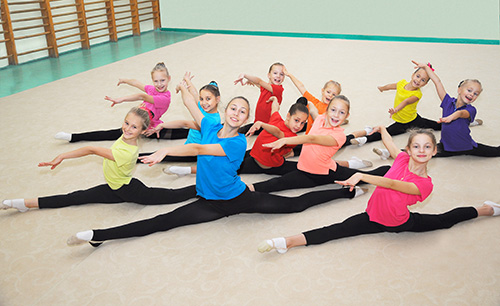You start each class with a group warm up exercise, which helps prepare the muscles and minds of your students for the practice ahead. Your students expect that each class will begin the same way, and they try to perform the movements in unison with each other. When it comes to competitions, though, this go-to warm up is a little less reliable. Your dancers might travel separately to the competition venue, or maybe there’s limited space, and it ends up that each of your dancers’ stretches on their own, off in a corner or hallway, or in pairs.
While independent stretching before competitions is unproblematic for advanced, experienced dancers, a group warm up exercise before competitions can be incredibly beneficial. Just make sure that you take up as little space as possible and choose a warm-up location that’s away from high-traffic areas.
Boost Performance and Reduce Injury
The main goal of warming up is to raise the body’s temperature by a few degrees, noted Jan Dunn in a post for 4Dancers.org. By increasing body temperature, you lubricate your joints, boost blood flow to your muscles, raise your breathing rate and strengthen your mind-body connection. A warm-up that is not done properly or is insufficient can lead to injury and hurt a dancer’s performance.
Younger or inexperienced dancers likely do not have a thorough understanding of what a correct and effective warm-up entails. By leading a group warm-up with all of your dancers before a competition, you can ensure that each and every one of your students has fully prepared their muscles to perform safely and at their best.
Increase Focus
Nerves are high before a competition, and when a student is off on her own stretching and watching dancers from other studios warm-up, her nerves can jump up even higher.
“Getting engrossed in others’ dancing could make you nervous or subliminally lower your expectations for yourself,” wrote Amy Brandt for Pointe Magazine.
A group warm-up before a competition allows your students to focus on you and each other, and not the dancers they’re competing against. By following your warm-up instructions, they can focus on their own skills and better drown out noisy distractions.
Comprehensive Preparation
An effective warm up exercise routine includes a variety of movements and stretches, and it’s much easier for dancers to forget certain movements if they’re warming up independently. A thorough warm-up involves three stages, passive, general and specific, explained Dance Advantage.
The passive warm-up is simply making gentle movements while wearing legwarmers and other layers to raise body temperature. The general warm-up, which is 5 to 10 minutes of light cardio, is likely the warm-up stage most skipped over by dancers, according to the site. And the specific stage is when unique movements are done to work the main muscle groups that will be taxed during the performance, and includes barre and center work.
A thorough, multi-stage warm-up is the best preparation before a competition.



